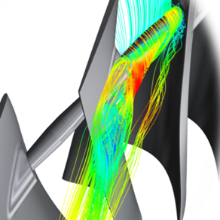Measurement of steam turbine flows and vibration behavior of blades
Steam turbine last stage blading has been investigated at the ITSM's last stage test rig (ESTV) for many years. In addition to the continuous precise measurement of thermodynamic and power-related quantities for the determination of the efficiency, probe traverses for the detailed investigation of the flow field (e.g. steam wetness, steady-state as well as transient pressures, etc.) are also possible. The rotatable outer diffuser of the test rig allows a stepless variation of the measuring position in circumferential direction. Furthermore, the ESTV has an excitation system developed at the institute, whereby various nodal diameters of different vibration modes can be excited in a targeted manner. This allows the aerodynamic damping of the blading to be determined.
Numerical investigation of steam turbine flows
The concept of the ITSM also includes the constant accompaniment of all measurements with numerical flow calculations. Therefore, CFD-calculations and structural simulations are carried out both for detailed prediction of the flow field and for determination of the aerodynamic damping behavior of steam turbine final stage blades. In addition to conventional ideal gas calculations, real gas calculations with complex modeling of the thermodynamic non-equilibrium are conducted. This makes it possible to gain detailed insights into the location of droplet formation, droplet growth and their influence on relaxation and aeroelastic behavior. Further information in the section aeromechanics.
Investigation of wet steam flows and validation of simulation models
Especially in steam turbines, condensation, i.e. the formation of droplets, plays a major role in the expansion of steam. At ITSM, these nucleation processes are investigated with nozzle experiments. In these experiments, superheated steam is expanded through a nozzle at very high flow velocities. The resulting droplet spectrum and the effects on the flow field can be analyzed by optical laser measurements and pressure measurements. The experiments are always accompanied by CFD-simulations applying sophisticated modeling of the condensation process. This allows both the modeling of the flow to be improved and additional knowledge regarding the influence on the flow to be gained.
Investigation of coupling elements in rotor blades
Especially with long rotor blades, vibration phenomena can occur. These can lead to the destruction of the machines in a very short period of time. Therefore, coupling elements are used between the blades to reduce the vibrations. The influence of these coupling elements on the flow field is investigated both numerically and experimentally at the ITSM in order to increase the efficiency of the machines and to ensure safe operation.





